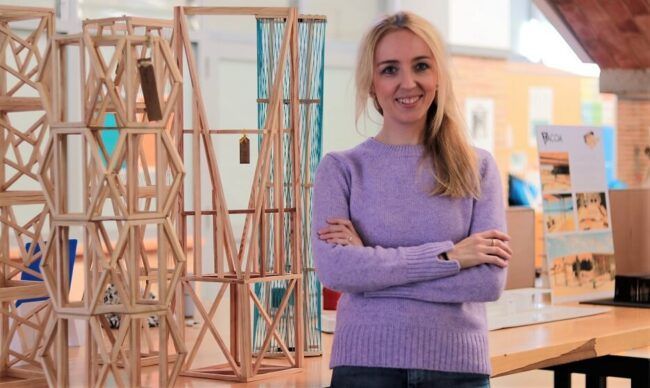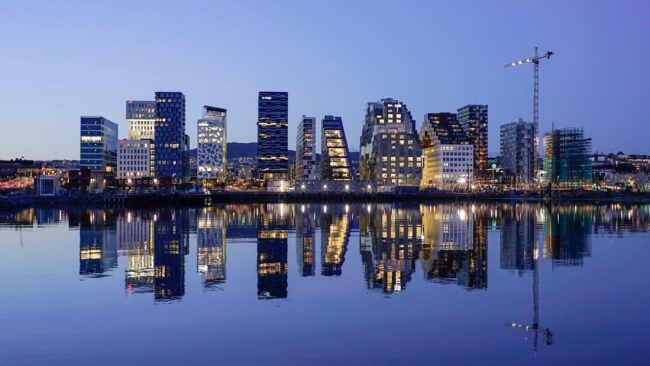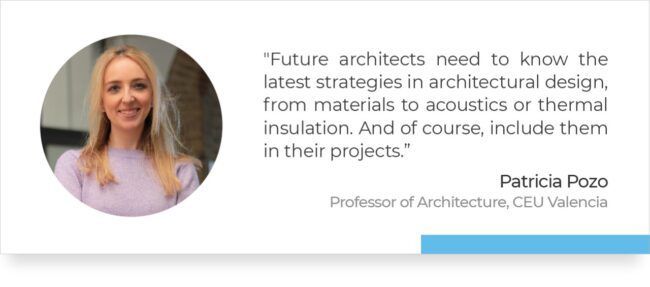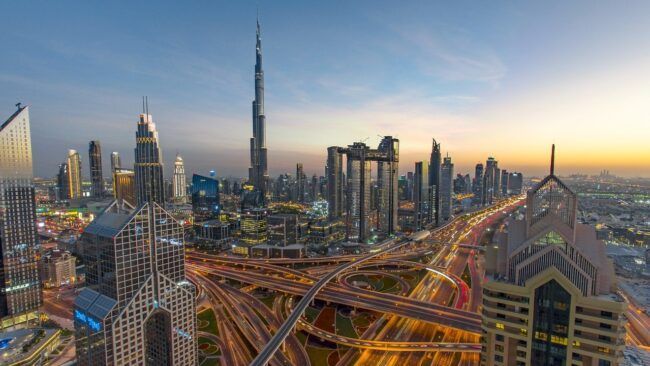Green, bioclimatic, conscious: sustainable architecture takes the environment into account and puts firs in its projection the efficiency of materials, bioclimatism and construction techniques. A totally necessary sustainable approach of current interest that should guide us towards greater respect for nature, the planet and the people who inhabit it.

We have been able to discuss concepts such as bioclimatism or environmental strategies with Patricia Pozo, PhD in Architecture and lecturer at our School. Concepts that, contrary to what one might think, are not as new as they seem…
Sustainable architecture, a classic concept
Patricia, where did the idea of sustainable architecture come from? Is it a post-modern concept or does it have a historical background?
In the past, classical architecture already worked on the construction and material strategy as something indigenous and local, thinking of a specific geography and place. Gradually that conception changed towards a more modern vision, which is when problems began to arise: poorly oriented buildings, air conditioning, discomfort and wellness problems, etc. One of the principles of sustainable architecture would go back to that historical origin and place people’s well-being at the epicenter.
Energy efficiency and climate change have undoubtedly generated a new stream of architecture that, in fact, is almost a specialty in itself. But we must not forget other aspects of sustainability that address social issues and that are also very important. It is necessary to tackle and standardize the accessibility of buildings, for example. And this subject is sometimes forgotten, especially when we are faced with a more sculptural architecture, designed more to impress the citizen.

International cooperation should not be forgotten either, and sometimes a lot can be learned from how things are built in less favoured places. In Africa, for example, self-construction based on indigenous materials abounds: communities build their villages with the best materials available to them, something much more sustainable than replication.
Why do you think there are people who deny sustainability? Is it possible for sustainable architecture to be both modern and visually attractive?
Faced with realities such as the environmental challenge, one always comes across defenders and detractors. There are people who associate sustainability with just a fad, with something new and the label “green” or “bio”. Whilst other people continue to deny climate change. But there are studies that show that the climate is evolving and that we need to drive change. It is also true that the current levels of construction, transportation or movement, which generate so many environmental problems, did not exist in the past. In any case, I believe that the debate is necessary and enriching; all views must be understood, no matter how skeptical they may be.
It is very good that industries such as fashion or architecture become aware and propose solutions or alternatives. In architecture there is a benchmark and that is Antoni Gaudí: all his constructions have vegetal references. Trencadís, which is so typical, is no other than an allegory of recycling: he did not discard broken tiles but rather reused them and turned them into a work of art, an incredible facade. It is that perception that is important and helpful.

Gaudí was very connected with nature; in fact, his architecture tried to reflect nature through form and geometry. Some later constructions have changed that vision. I am not sure that the new façades of the Sagrada Familia are exactly as Gaudí envisioned them but the idea of verticality has, for example, been maintained. It is a piece that calls the faithful, that stands out over the urban fabric that Cerdà devised, and it has managed to be a benchmark in Barcelona. It is a work of enormous vertical power but without losing the curve, the organic.
This sustainable architecture is not a fad and, in fact, it is a topic that can be connected with Art History, one of the subjects you we teach here at ESET. Why do you think classical architecture was more sustainable than modern architecture?
The difference between the classical Roman and Greek empires, as well as the Islamic cities, and the current ones, is substantial: the construction was then thought very rationally and considering the city as a whole. If you visit a Roman, Greek or Islamic city, you will always find a cultural reference. In other words, the identity of these cities is inextricably linked to a culture and, based on it, the different spaces that make up the city can be understood. And also according to geography, climate and local materials.
Each culture developed its cities around public spaces. In Islam, for example, the mosque is the central point around which all meeting and exchange spaces are articulated: the squares, the bazaar and the markets. On the other hand, the weather also influences its private architecture and urban planning: a dense, organic layout, with narrow streets to favor shade, as well as houses that are closed to the outside. Houses that, however, open onto interior patios that, apart from having other connotations, fulfill their bioclimatical function very well. These patios are fresh, since cold air accumulates there and they introduce fountains and ponds to generate evapotranspiration. When designing a building, one should think about all these elements: location, orientation, ventilation…

The current landscape is totally different and I do not know what is better or worse. I do think it is important for an architect to consider why a Roman, Greek or Muslim city worked so well and why they paid so much attention to the urban and constructive levels.
The present and the future of sustainable and ecological architecture
Doha, Dubai… Do you see traces of Islamic culture in these great cities? They are very apparent but they look like hypermodern versions of New York…
And not just those cities; today, there is an unstoppable trend towards the icon. There is an idea in architecture that considers the building as an icon or as a tourist attraction. In Paris, for example, the Eiffel Tower was built as a symbol of the industrial revolution and the identity of an era. This icon has become the symbol of France and Paris. In fact, it was supposed to be disassembled but it is still there.
This trend is nothing more than the search for an identity: “we are a modern, cosmopolitan city, open to innovation and design”. And that is why powerful buildings are created, such as large skyscrapers, which we associate with power and economic muscle. Sustainable architecture is not ensured.
In Dubai or Qatar everything is associated with the idea of opulence, of an emerging and excessive luxury. And that wealth must materialize in buildings that are very visually powerful and can be elevated to the category of icon. The four towers of the CTBA in Madrid follow that trail: they were built to break the Madrid sky and in the end they have become an attraction. Here it did not have such a big impact because Madrid is still a European city with a long history but it is something very radical in Qatar: huge football stadiums are being built in the middle of the desert, in a country with no sports tradition.

There are many buildings that are created without thinking about their sustainability – glass is a good example. It is used a lot because it looks great, it comes from the modern movement that reinforces the ideas of cleanliness, modernity, technology or transparency. However, in very hot climates it has a disastrous effect and requires a huge investment in air conditioning and maintenance. All these new buildings that lack a bioclimatic strategy adapted to the location, will fall from grace if they do not receive investment. They are not sustainable, not even from an economic point of view.
Do you think there is a professional future for architects in terms of sustainability?
Sustainability is already a specialization in itself. Architecture has always been adapting to the needs of the time, to the prevailing artistic movement, to the economy, to society… Years ago we lived through a boom that ended in a crisis and brought with it uncontrolled urban planning. They stopped thinking about the good of society and wanted to make the most of space to seek profitability. In architecture we went from having spacious houses, with high ceilings and more metres, to having smaller spaces.
That boom also altered the landscape – I remember, for example, Mar Menor and all the ecological destruction resulting from the excess building. Economically, it fosters tourism but the impact in that area has been enormous at an environmental level.
“SUSTAINABILITY IS ALREADY A SPECIALIZATION IN ITSELF THAT is creating JOBS.”
The architects of my generation joined the labour market precisely when that bubble burst, and that was when the issue of sustainability became known both as an analysis of the reality of the moment and also as a critique of foreign models such as the British garden city or the American suburb.
The new generations of architects are aware of the situation, both at an urban and building level, and are starting to specialize in this area: energy efficiency, bioclimatism, sustainability, international cooperation… At universities like ours, these ideas are now integrated into the academic programme. And I consider it important that students participate in this reality and that debates are held about the world around them and how to improve it.
Most of the people who have specialized in these areas are currently working, inside and outside of Spain. It is a specialty that has been introduced in our society and is creating jobs.
Is there any building in Spain that you consider a good example of architectural sustainability?
Again, I have to mention the classics. Thermal inertia, for example, is a phenomenon that makes it possible to maintain stable temperatures inside buildings. This is seen very clearly in cathedrals, churches, or even in town houses. These are thick-walled constructions, masses that generate thermal inertia and store heat in winter, as well as cold in summer. It seems like something very simple – comfort and thermal protection are achieved thanks to the use of this construction technique. With this example you can already understand what bioclimatism and sustainability are.
I could give many examples in modern architecture but to mention one here I want to highlight the solar house of Solar Decathlon Europe. It was a contest in which we participated with an energy efficient house and the final project was much praised. It was a great experience because the participating universities presented very interesting proposals. I remember a house with clay cladding that created an interesting and effective “jug” effect, as well as other projects of self-sufficient buildings that dumped excess energy in the city.
Creativity and the search for solutions are certainly not at odds with technology or construction techniques.


























